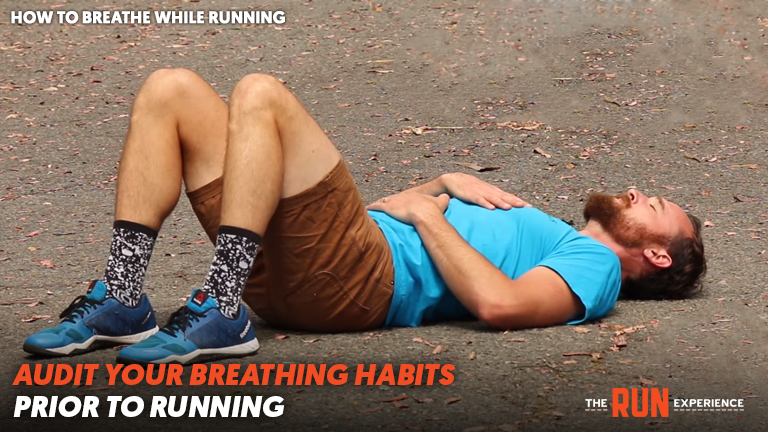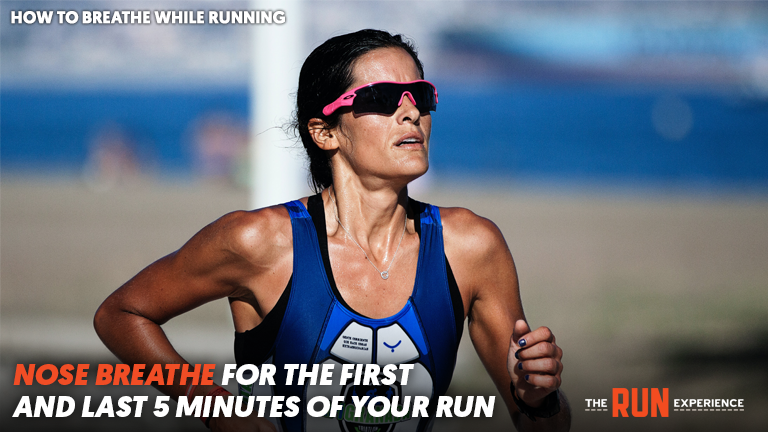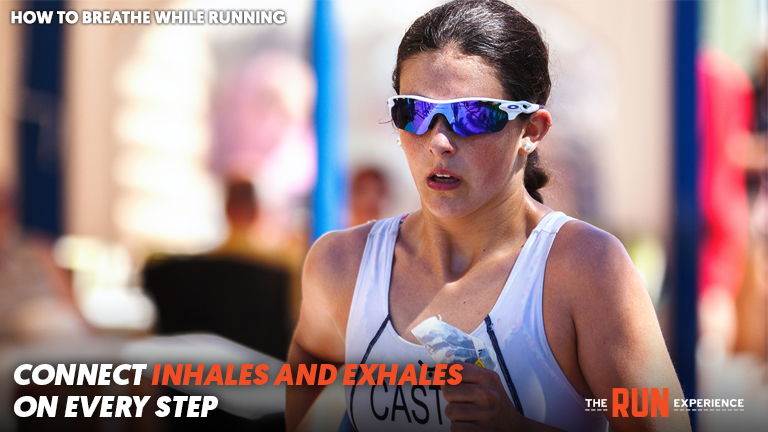How to Breathe While Running | Must-Try Breathing Exercises
Learn how to breathe while running with these running breathing exercises, techniques, and practical tips to make seamless running a reality.

Ever notice how some runners make it look effortless? Like they're just floating along, having a casual chat, while you're over there sounding like Darth Vader after climbing a flight of stairs? (Don't worry — we've all been there.)
Here's the thing about breathing while running: it might be the most natural thing in the world (you're literally doing it right now), but doing it efficiently while running? That's a whole different story. And if you're struggling with your breathing on runs, you're not alone — it's one of the most common questions we get at The Run Experience.
Think about it: most of us spend our days hunched over desks, taking shallow breaths, then suddenly expect our bodies to know exactly what to do when we hit the pavement. It's like asking someone who's never played piano to sit down and perform Mozart. Sure, they can press the keys, but making music? That takes practice.
The good news? Just like any other running skill, breathing can be trained, refined, and mastered. Whether you're a beginner trying to make it through your first mile without gasping or a seasoned runner looking to optimize your oxygen intake, we've got you covered with practical techniques that actually work.
How to Breathe While Running
Learning how to breathe efficiently while running is a crucial skill that can significantly enhance your performance and enjoyment of the sport. For many runners, both new and experienced, finding the right breathing rhythm can be challenging, but with practice and understanding, it becomes an integral part of a successful running routine.
Rhythmic Breathing
Developing a rhythmic breathing pattern that synchronizes with your running stride helps maintain a consistent pace and prevents side stitches. This synchronization ensures that your body is efficiently using oxygen and expelling carbon dioxide.
Start by identifying a comfortable breathing pattern, such as inhaling for three steps and exhaling for two, and adjust as needed based on your pace and intensity.
Diaphragmatic Breathing
Diaphragmatic, or belly breathing, allows for deeper, more efficient breaths. By engaging the diaphragm, you increase your oxygen intake and enhance your endurance.
Incorporate diaphragmatic breathing exercises into your daily routine to strengthen this muscle and make belly breathing more natural while running.
Nasal and Mouth Breathing
There's a debate in the running community about whether nasal or mouth breathing is more effective. Nasal breathing can warm and filter the air but may not be sufficient for high-intensity runs. Mouth breathing allows for more significant oxygen intake, especially during strenuous activity.
Many runners find a combination of both methods works best. Practice breathing in through the nose and out through the mouth, especially during less intense runs, and switch to mouth breathing during higher intensities.
Adapting Breathing to Running Conditions
Your breathing should adapt to the intensity of your run. For easy jogs, a relaxed and deep breathing pattern is suitable, while faster paces may require quicker, more shallow breaths.
Pay attention to how your body responds to different breathing techniques and adapt accordingly. If you're feeling winded or experiencing side stitches, it might be time to adjust your breathing pattern.
Control Your Breathing When Running
Controlling your breathing is a challenge for most runners. Prior to hitting the trails, beginner runners should audit their breathing rhythm to see if they have the lung capacity to complete the run.
To do this, they can perform a variety of breathing exercises that will help them assess their breathing rhythm and ensure they have the proper breathing while running technique nailed down.
Why Is Breathing While Running So Challenging At First?
Stop what you’re doing. What sort of position is your body in right now? Are you seated or standing? Slouched over or slumped back on the couch? Well, believe it or not, the way in which you breathe is affected by the positions you spend most of your day in.
Slouching over can cause our breathing to get shallow. Instead of performing diaphragmatic breathing for deeper, more valuable breaths, everything stays up in our chest, creating little to no value for our overall aerobic capacity.
When it comes time to run, you’ve programmed yourself to take short shallow breaths. This can make you feel like you’re gasping for air even on the simplest jog or warm up run. That’s why preparing yourself for proper breathing while running takes place way before your run begins.
Breathing for runners comes down to regularly expanding your lung capacity by training at mid-high heart rate zones regularly and thus, constantly improving the body’s ability to utilize oxygen and release carbon dioxide more efficiently.
Thankfully, we’ve outlined a few breathing exercises below that you can try to improve your breathing rhythm. There’s no need to scan social media or search on Google for these running tips. Our strategies are great for new runners at all fitness levels trying to learn how to breathe properly while running.
Let’s take a look at a few ways new runners can improve their breathing mechanics.
Best Breathing Techniques and Exercises for Running
You’re not stuck with the way you’re feeling right now. With a little practice, you can learn how to improve your breathing while running and start getting the oxygen you need to push the pace.
Below, we’ll walk you through our favorite breathing exercises for running—and we’ll show you the best breathing technique to optimize how much air you’re getting.
Breathing Exercise #1: Deep Belly Breathing
Figure out how you breathe with a breathing audit. Since breathing is an involuntary action, you might not really know how you breathe unless you stop and think about it. To figure this out, perform a deep belly breathing exercise.
Deep belly breathing is a simple three step process to assess your current breathing technique. All you need to do is lie down on your back, put one hand on your chest and the other on your belly and take a few breaths. Take note where most of your breaths are happening—either in your chest or your belly.

To activate your diaphragm, perform this deep breathing drill. Start with a large inhale through your nose that fills your chest, mid-chest and then belly. Reverse the cycle when you exhale through your mouth—not your nose. Repeat these deep long breaths (hands still on belly and chest) for 10 repetitions.
This puts the diaphragm in motion with rhythmic breathing that fills your entire lung cavity with the maximum oxygen possible.
Breathing Exercise #2: Nose Breathing
Now, it’s time to use what you’ve just learned and implement it on your next run. Before you go out for that next run, spend a few moments practicing breathing only through your nose. You can do this by closing your mouth and taking 8-10 breaths using just your nose.
You’ll notice the belly breathing (instead of the shallow chest breathing) kicks in right away.
To more fully rely on nose breathing, try breathing only through your nose for the first and last five minutes of one of your easy runs. If you’re not used to breathing this way (especially during exercise), there’s a good chance that the nose breathing will make you feel like you can’t get enough air. This is totally normal.

To help calm you down, adjust your pace and effort level to accommodate the nose breathing. Slow down and take control. If you feel that you’ve mastered it, though, you can make the breathing exercise more challenging.
As you get more comfortable, increase to 7-10 mins at the beginning and 7-10 mins at the end. Once that feels doable, try running the first 30-40 mins of your run using just your nose to breathe. You can also speed up the nose breathing. Try running 1 mile at a faster pace, breathing only through your nose.
Breathing Exercise #3: Match Your Breathing and Cadence
The last piece of this puzzle is simply matching your new breathing to your running. The bottom line is that runners should do what every running coach has ever told them: inhale and exhale with each foot strike. This can result in efficient breathing that is in rhythm with your step.

To achieve this, start running in place at a moderate pace. Next, count how many steps it takes to inhale and exhale. There’s no right number here; it’s important to just make a note for yourself.
Consider this your breathing baseline. From here, start playing with changing the number of your breaths on command.
For example, if you were inhaling for four steps and exhaling for four steps, try inhaling for four steps and exhaling for six steps. Play with this for a few minutes in place.
Consider this a new “gear shift system” for your running. Depending on the speed and intensity of your run, race, or marathon, you should be able to match your breathing to your movement.
You’ll notice that at a quicker pace, the number of steps per inhale/exhale may decrease. During an easy run or a slower long run, it may increase.
There is no right number of steps per inhale or exhale. There is only the right amount for you.
This drill is for you to figure out what you need at various speeds and intensities. With this training, you’ll be able to shift into a familiar breathing mode to complete a high-intensity run in a methodical, rhythmic way.
Tips and Best Practices to Master Breathing While Running
Effective breathing techniques not only improve your performance but also increase your comfort and endurance during runs. Whether you're a seasoned marathoner or a beginner, these insights are designed to assist you in developing a breathing rhythm that complements your running style.
- Establish a Breathing Rhythm: Start by establishing a consistent breathing rhythm that matches your stride. Experiment with different patterns, such as a 2:2 (inhale for two steps, exhale for two steps) or a 3:2 ratio, to find what works best for you.
- Practice Diaphragmatic Breathing: Focus on diaphragmatic (belly) breathing to maximize oxygen intake. Practice this technique during rest and incorporate it into your runs for deeper, more efficient breaths.
- Gradual Transition to Nose Breathing: Begin with nasal breathing during low-intensity runs and gradually incorporate it into more strenuous runs. Nasal breathing can help regulate breaths and increase CO2 tolerance.
- Stay Relaxed: Keep your body, especially your jaw and shoulders, relaxed. Tension can restrict breathing, so focus on maintaining a relaxed posture.
- Adjust Breathing with Intensity: Be prepared to adjust your breathing pattern based on your running intensity. Quick, shallow breaths might be necessary for high-intensity intervals, while longer, deeper breaths are more suited for easy runs.
- Focus on Form and Posture: Maintain an upright posture with a slight forward lean to facilitate better lung expansion and efficient breathing.
- Use Breathing as a Pace Regulator: Use your breathing rhythm as a guide to set your running pace. If you're struggling to maintain a steady breath, it might be a sign to adjust your speed.
- Build Lung Capacity: Incorporate exercises like swimming or activities that challenge your respiratory system into your cross-training to build lung capacity and endurance.
Practice Proper Running Breathing
Taking time to assess and adjust your breathing is an essential part of training. By doing so, you can increase your oxygen intake and decrease your chances of side stitches or side cramps while maintaining your pace for the duration of your run.
Learning how to breathe while running is just the first step—now, it’s time to get out, practice, and adopt these fundamentals.
No matter your skill level, there is always room for improvement in breathing while running. Whether you are preparing for a half marathon, 5K or any type of cardio, try incorporating at least one of these running breathing techniques into your running training each week. By doing so, you’ll be prepared once the gun goes off and you take your first breath.
Incorporate Tips for Running Breathing into Training
Want to take these tips for running breathing into your normal training routine? We’ve got just the thing.
Follow along with our guided running workouts on The Run Experience mobile app. Download it here. You can try it out for free with a trial plan or just experiment with the free workouts we have available.
Our guided workouts will remind you about proper breathing technique while running, queuing you in to the tips, exercises, and techniques we shared in this article.
Put this into practice, and you’ll learn how to breathe while running like a pro in no time.
